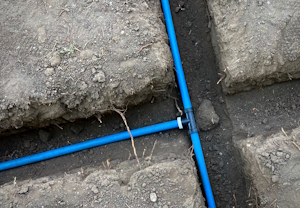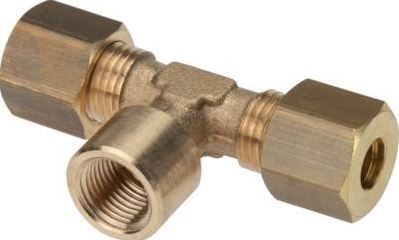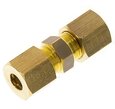Compression Fittings & PEX

Figure 1: A compression fitting with three connections joins PEX piping in an underground irrigation system.
Compression fittings offer a practical solution for securing PEX tubing, ensuring a watertight seal in diverse applications. This article focuses on the selection criteria for choosing the right compression fittings for PEX, highlighting the importance of material compatibility, size, and resilience under varying pressures and temperatures. Understanding these factors is essential to maintaining the integrity and performance of PEX piping systems.
Table of contents
View our online selection of compression fittings!
What is PEX?
PEX, or cross-linked polyethylene, is a versatile plastic material used primarily in pipework systems, hydronic radiant heating and cooling systems, and domestic water piping. Its unique properties are due to the cross-linking of polyethylene molecules, which enhances the material's performance under high temperature and pressure conditions.
Material composition
- PEX is made from polyethylene, a polymer transformed through a chemical process known as cross-linking.
- Cross-linking changes the thermoplastic nature of polyethylene to a thermoset material, which means PEX can better withstand heat and mechanical stress.
Applications
- PEX is most commonly used for indoor plumbing applications due to its flexibility, which allows for fewer fittings and easier installation.
- It is suitable for hot and cold water supply lines, offering a durable and corrosion-resistant alternative to traditional piping materials.
- PEX's resistance to scale and chlorine and its ability to retain heat make it a popular choice for radiant floor heating systems.
- The material is also used in ice rinks, where its thermal properties are essential for maintaining the ice surface.
What is a compression fitting?
A compression fitting is a type of coupling used to connect two pipes or a pipe to a fixture or valve. It seals fluid within the pipes and prevents leakage through tight seals. The design of a compression fitting is relatively simple. It consists of three main components: a compression nut, a compression ring (often called an olive or ferrule), and a fitting body.
The operation of a compression fitting begins with the pipe being inserted into the fitting body. The compression ring is placed around the pipe, and the nut is threaded onto the fitting body. As the nut is tightened, it compresses the ring against the pipe. The compression of the ring deforms it slightly, causing it to grip the pipe and create a seal against the fitting body.
The compression fitting's design allows it to be used with various pipe materials, including copper, steel, and plastic. Its operation does not require heat or solder, making it a convenient choice for situations where the use of a torch is impractical or dangerous. The mechanical seal that the compression fitting creates is achieved through the physical force of tightening, which can be done with common hand tools.
Compression fittings and PEX
Compression fittings are used in a variety of plumbing applications due to their ease of installation and reliability. With PEX tubing, these fittings are commonly employed in:
- Residential and commercial water supply lines
- Radiant floor heating systems
- Ice maker installations
- Repair situations where a section of pipe has been damaged or needs to be replaced
There are several reasons why compression fittings are particularly well-suited for use with PEX pipes:
- No need for special tools: Unlike other PEX connection methods like expansion fittings or crimp rings, compression fittings do not require any special tools. This can be beneficial for DIY projects or quick repairs.
- Removability and reusability: Compression fittings can be easily removed and reused, making them convenient for temporary setups or systems requiring frequent adjustments.
- Flexibility: PEX tubing's flexibility makes it compatible with the slight movement and adjustments that compression fittings allow.
- Durability: Compression fittings for PEX are designed to withstand the expansion and contraction that occurs with temperature changes in plumbing systems, maintaining a tight seal over time.
Limitations
Despite their advantages, there are situations where compression fittings might not be the best choice for PEX pipes:
- Permanent installations: For permanent plumbing installations, methods like crimping or expansion offer a more robust solution as they are less prone to potential leaks over a long period.
- High-pressure applications: In high-pressure systems, the risk of a leak with compression fittings can be higher than with other connection methods. Ensuring that the fitting is rated for the system's pressure requirements is essential.
- Exposure to UV light: If the PEX piping is exposed to sunlight, UV rays can degrade the material over time. In such cases, it is crucial to use fittings and pipes that are specifically designed to be UV-resistant.
Selection criteria
When selecting a compression fitting for PEX tubing, it's important to focus on the fitting's properties; not every compression fitting works well with PEX. Focus on the following criteria:
- Material compatibility: The fitting's material must be compatible with the PEX tubing to prevent chemical reactions. Brass compression fittings are commonly used, but it is important to ensure they are lead-free if used for potable water systems. Stainless steel and plastic fittings are also suitable.

Figure 2: Brass is a suitable material for compression fittings used with PEX.
- Size and dimensions: PEX tubing is available in different sizes and it is necessary that the compression fittings match the outer diameter of the tubing. An improper fit can lead to leaks or reduced water flow. The fitting must also support the wall thickness of the PEX tubing to ensure a secure and stable connection.
- Pressure and temperature ratings: PEX tubing is often used in systems with varying pressures and temperatures. The compression fittings must withstand the maximum expected system pressure and temperature without failing.
- Type of PEX: PEX tubing comes in several types, such as PEX-A, PEX-B, and PEX-C, each with different flexibility and resistance properties. The chosen compression fittings should be suitable for the type of PEX tubing in use, ensuring a strong seal and preventing potential leaks.
- Certifications and standards: Ensure that the compression fittings meet industry standards and hold the necessary certifications. These may include standards set by organizations like the American Society for Testing and Materials (ASTM) or European Standards. Compliance with these standards assures the quality and safety of the fittings.
- Durability and corrosion resistance: PEX tubing is known for its long lifespan, so the compression fittings used should match this durability. They should be resistant to corrosion, especially in environments with hard water or where the fittings may be exposed to other corrosive substances.
- Application-specific features: Depending on their use, such as in radiant heating systems or potable water lines, compression fittings for PEX tubing may require additional features. For example, in radiant heating systems, the fittings may need to withstand long-term exposure to hot water.
FAQs
Can you use compression fittings on PEX?
Yes, PEX can be used with compression fittings. It is necessary to ensure the fitting meets the application criteria (e.g., pressure and temperature) to prevent leaks.
Can you use brass compression fittings on PEX?
Due to its toughness, a brass fitting can be a reliable choice for PEX tubing. If used in a potable-water system, ensure the fitting is lead free.





